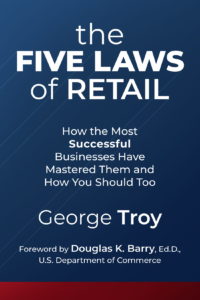3 Reasons Why Barnes & Noble Is Struggling: RETAIL STORE WALK-THROUGH #1
A retail walk-through is a cursory physical review of a store and its business. The term refers to the senior leadership of a retail company walking around the store with the specific store’s management while looking at the visual presentation and stock assortment. This team discusses sales trends and solicits feedback from the sales staff about that store’s customers.
If you’re in the department store business, you can always spot them. Where else would you see a gathering of middle-aged men in suits looking solemnly at a display fixture of socks or a table of towels, all nodding seriously when the most senior among them makes some brilliant observation about the opportunities in the sock business.
This is the first of a series of “walk-through” retail blogs. You can discern a surprising amount from a walk-through about a store’s content and slow sellers, about what seems to be working and what doesn’t, and of course about the company’s culture.
Who Am I, and Why Does My Opinion Matter?
I’ve been leading great retail teams for decades, from department stores to specialty stores and big boxes. And now I consult and write for retailers of all kinds. So these walk-throughs and the conclusions drawn are the result of having done them innumerable times across many consumer categories. It is fun, like a puzzle to figure out what’s going on.
For the Walk-Through series I’ve chosen to review retail companies where there is something interesting going on. Either the companies are reported to be in trouble and we want to figure out why, or they are exceptionally successful and innovative. They might be breaking into a whole new category. Whatever the reasons, I think you’ll begin to see a pattern about what works and what doesn’t. You see, because I spent my career in retail merchandising, I discovered that there are Five Laws of Retail—specific rules that determine a company’s success or failure. The execution (or lack thereof) these Five Laws can often be determined through a “walk through” of a physical store.
Applying the Five Laws of Retail
Because I believe any company can be successful if they follow the Five Laws, part of the process here will be to offer suggestions for building on current successes, turning around a troubled company, or taking it to the next level.
As a consumer, you already know a lot about the Five Laws of Retail (and you can learn more here). One term you might not be familiar with, though, is omni-channel, which means a customer can review and purchase products easily across channels: in-store, on-line, through a mobile device, or via a catalogue. Most of the stores I’ll review are expected to have some iteration of an omni-channel strategy. .
Please let me know if there’s a Walk Through for a specific store that you would like to see.
WALK-THROUGH #1: BARNES & NOBLE (booksellers)
Why Barnes & Noble Is Struggling
Hint: It’s not because of ecommerce
Barnes & Noble is, and has been, having trouble. Everyone is quick to blame competition from Amazon and other ecommerce stores for eroding their business. To some extent that may be true, but a quick walk though one of the stores reveals many other systemic reasons as well.
Focus
First of all (and perhaps most important), I don’t think Barnes & Noble has decided who they want to be. In addition to books, their stores carry scented candles, toys, DVDs, games, dolls, and all kinds of crap. Once you enter through the front door, you must maneuver though about twenty feet of this stuff before you even get to a book.
A retailer can’t be everything to everyone all at the same time. While some gifts at holidays may make sense, devoting a large percentage of the real estate in a bookstore to tchotchkes other than books doesn’t look quite right.
And judging from their reported results, this merchandising plan does not seem to be paying off for them.
It is the responsibility of management—the company’s leadership—to focus the vision. They must clearly define and articulate what they want to be and who their customer is.
B&N violates Law #3: It’s Always the Product.
Inventory
My god! What a disaster B&N’s inventory is. There so many SKUs that that management could not possibly even know how many products they have. The turn must be abysmal; that alone can be the kiss of death for a retailer. When you have too much inventory spread over too many SKUs, then you lose on both ends of the product/inventory chain.
You lose sales volume because you don’t have enough of the stuff people do want—in this case, probably books. Then you lose on the other end because the other stuff—probably scented candles—takes up space and does not sell, and you are forced to reduce prices in order to liquidate. Or worse yet, you must hold on to poorly performing inventory hoping for better days that never come. Then your inventory becomes aged. This is a violation of Law #2: Turn Is Magic, and it’s hurting B&N’s bottom line.
Physical Plant
The B&N stores are just too damn big. There was a trend in the ’90s for “bigger is better” stores in many categories of merchandise. B&N obviously went that route, and it worked for a time. When you upsize, you do get a sales bump just because you offer more to sell, but in B&N’s case the sales increase does not appear to have been sustainable.
Their sales per square foot must be as abysmal as the turn.
So, we already know from their own reports that Barnes & Noble’s top-line sales revenue is off. It’s easy to learn from a walk-though that their turn and sales per square foot are bad. That indicates clear violations of several of the Five Laws of Retail; #2, Turn is Magic, and the third, It’s Always the Product, for certain. The other laws, like #5, Protect Your Downside, can be difficult to discern (but I hope they got that one right).
Strength
Barnes & Noble has great brand-name recognition, and that is an asset with real value. Plus they are almost literally the last man standing in the chain-book-store category. They have some really good locations, and I hope they have negotiated advantageous lease agreements. They have a good customer loyalty program and the basis for an omni-channel strategy. So, I believe they are addressing The First Law of Retail, People First, in a positive fashion by building community and relationships between customers and the company.
What’s to Be Done? 5 Ways B&N Can Fix Their Problems
A lot needs to be done to turn B&N around, and it won’t be easy. The company must simultaneously:
1.) Do the hard, soul-searching work it takes to clearly define who they are and what they want to be.
2.) Liquidate old non-productive inventory. This can be a painful and expensive hit to the profitability for a period of time.
3.) I think they must re-imagine their stores in a very innovative way and in a way that pays honor to the character and flavor of bookstores.
4.) They must be absolutely ruthless in their choice of product assortment content.
5.) They must build on a positive company culture among their employees at all level.
It takes a lot of hard work to turn around a struggling company, which B&N reports they are and a retail walk-through confirms. But above all, they must be mindful of and adhere to The Five Laws of Retail in order to make the positive changes that lead to success.
Which of the Five Laws do you think B&N should focus on to turn things around?
If you have not participated in a retail store walk-through, pick a store and try it. See what you can learn.















